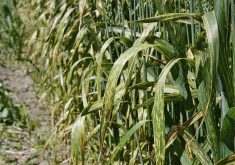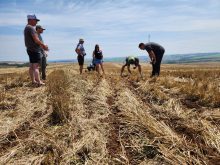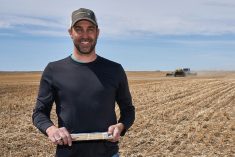There are a lot of products that growers can put on their crops, but do they really work?
That can be a difficult question at the best of times but it’s especially challenging in the rapidly expanding but little understood world of biostimulants.
The term has been around for many years but the closest thing to a formal definition might be this mouthful from an organization called the European Biostimulant Industry Council: Plant biostimulants contain substance(s) and/or micro-organisms whose function when applied to plants or the rhizosphere is to stimulate natural processes to enhance/benefit nutrient uptake, nutrient efficiency, tolerance to abiotic stress, and crop quality.
Mike Gretzinger has a plain English version of that.

“It’s anything that stimulates a natural process in the plant,” Farming Smarter’s research co-ordinator said during the organization’s recent field day. “It will improve nutrient uptake, minimize stresses and improve crop quality. It mimics things that are already happening in the plant.”
He likens them to protein powder, a hugely popular type of nutritional supplement that people take to build muscle, boost their workout, or even lose weight.
And like protein powders, there’s a whole lot of products out there — including growth regulators, humic acids and fulvic acids — that work on different parts of the plant, as well as microbial inoculates that play off the different mycorrhizal relationships.
There are federal and provincial regulations around biostimulants, but government isn’t in the business of judging their efficacy. Provincial regulations cover application, as well as the use and disposal of biostimulants while federal regulations cover labelling, registration and manufacturing. (All registered biostimulants are also deemed to be safe for the environment, humans and animal health.)
Read Also

Grazing ‘sweet spot’ boosts pasture performance
Timing-focused approach to pasture management touted to boost forage growth, livestock gains while also cutting farmer labour and inputs
The federal guidelines changed in 2013, when the government decided to revamp rules for biostimulants, allowing more of them into the market, including ones from other countries.
“That’s when we started talking about biostimulants here,” said Gretzinger.
Farming Smarter’s study on biostimulants was hard to get off the ground because of the number of players and products involved, he said.
The applied-research organization is currently working with four different chemical companies (all based in Western Canada) that are providing products to be tested. Different products will be used on peas, canola and wheat in three different locations. Along with Farming Smarter’s plots in Lethbridge, the Smoky River Applied Research and Demonstration Association will have plots in Falher, and the Battle River Research Group will have ones in Forestburg.
The treatments will be the same, and the crops will just be rotated. All plots were given a traditional treatment of nitrogen, phosphorus, potassium and sulphur.
The three-year study, currently in its first year, will be measuring a lot of intangibles, and there’s a limit on what researchers can do in terms of nutrient and soil biome testing, said Gretzinger. So they will be looking at different ways to evaluate the crops, including stand count, biomass, and the vigour of the crops. They will also be comparing pictures of the different treatments, as well as undertaking an economic analysis of each treatment system.
“It’s a small-plot approach, but a real approach,” said Gretzinger. “Can we find some good winners?”
















